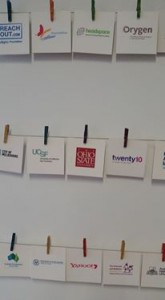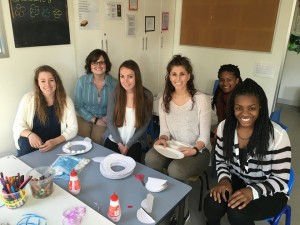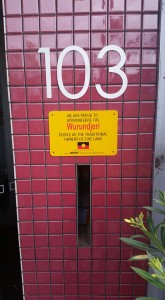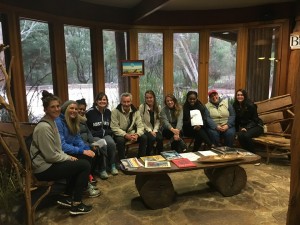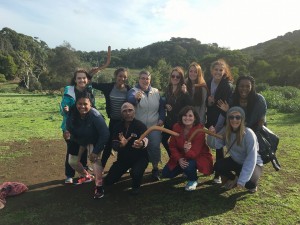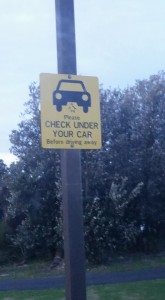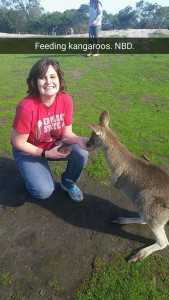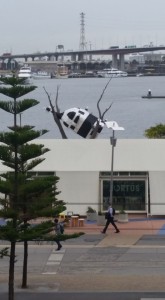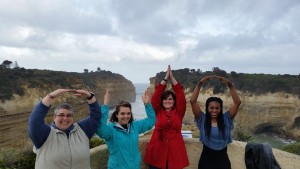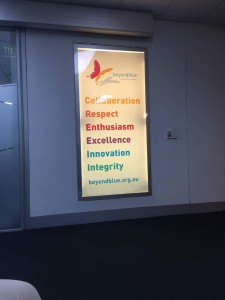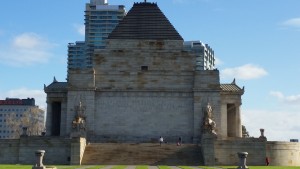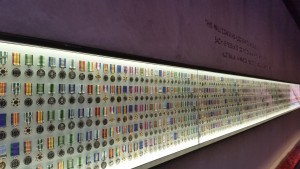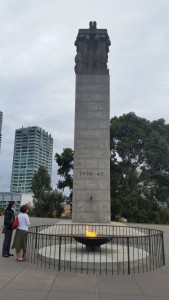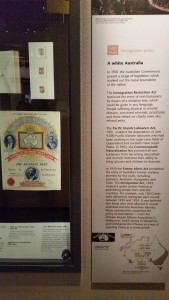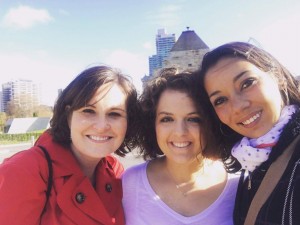Seeing How Other Countries Address Mental Health Has Illuminated My Path Ahead
While the physical time I spent in Melbourne might have only been three short weeks, the way it has shaped my thinking and understanding of the world will influence me for years to come. First, this program has furthered my understanding of how research and policies impact individual work and vice versa, and strengthened my interest in pursuing work in that area. Somewhere between meeting with Dr. Brophy (the head of research for Mind Australia at Melbourne University), our visit to the research collaborative Young and Well, and discussing the role of government committee membership with leaders at VICSEG, I decided I definitely wanted to pursue my Ph.D. This is because what I’d really like to do is perform research that I can then use to advocate for policy and programming changes, a connection I saw often throughout our agency visits. One element of this connection between research and practice that continued to jump out at me, and is something I want to incorporate into my work, is the way many agencies in their own ways empower and involve the youth/client. Young and Well and Reach Out do this in relation to Youth Ambassadors and youth voices in content development. Mind Australia surveys involved parties as a part of developing research questions, Lighthouse has a collaborative process in which clients rank their preferences for placements, and at VicSeg a clients’ culture is at the center of their activities and interventions. During my time learning about American social work, it has seemed that while we often talk about client-directed treatment at an individual level, but often it feels like we only involve others as subjects in research rather than active participants in the research process. Utilizing this client-centered framework more within research and policy development could lead to better implementation and treatment efficacy, in that clients are receiving a treatment researched and geared towards their expressed needs and preferences.
Another aspect of Australian mental health services that I would like to bring back to the U.S. is the emphasis on Family/Domestic violence. For instance, the Royal Commission, a government funded research publication on family violence that was released recently, came up at several visits. Furthermore, mental health services have a specific family violence program, rather than it be tacked on to other existing services. Mental Health providers work closely with other community partners like hospitals, schools and community health centers, and often go a ride alongs with police, and said police are required to make referrals for both parents and the child for mental health services. These policies and services and the evidence of their efficacy are something I’d like to use to push for change within American social service systems.
I really appreciated that Dr. Brophy pointed out that there is a lot of variance in services/climate/beliefs within different parts of Australia. It helped me to remember the Grass is Always Greener effect- I tend to focus on the negative parts of the U.S. and the positive of Australia, but both have strengths and areas for improvement, and often these are similar. For instance several agencies discussed how recent conservative governments have cut funding and impacted services, something we have certainly experienced within the U.S. One agency’s comment about a large contributor of homelessness being the lack of investment in public housing was very reminiscent of issues in the U.S., and I worry about the state of homelessness in both countries if this trend continues. Seeing how technology and globalization has really connected researchers and providers from every country and culture has deeply piqued my interest in international social work, particularly regarding issues such as homelessness, foster care, and internet as a utility, topics that seem almost universal.
In the end, while there are many differences, there are so many similarities between our cultures and indeed most cultures-hearing the kids in the at Berry Street sing Old MacDonald and just enjoy coloring and throwing balls reminded me of that.
Learning About the Aboriginal People of Australia Has Helped Me Reflect on Native Americans and American History
I thought it was so important that we started the agency visits with VACCA, as it really heightened my awareness of how colonization and the cultural genocide of the aboriginal people resonates throughout Australian culture, but especially within human services. Also, being part of the white majority both within Australia and the U.S., I thought it was especially important that we started with an honest discussion about systemic privilege and government-induced cycles of trauma. Throughout the visit I was frequently struck by how there are so many similarities between U.S. and Australian First Peoples and colonists’ interactions with them-from the decimation of smallpox, to government roles in stolen generations. It’s scary to think that during my parents’ lifetimes aboriginal children with a white parent could still be taken from their parents and worse that it was justified as being for “their own good”. All this felt very similar to U.S. government’s policy of removing Native American children with the justification of “killing the indian to save the child”. The cyclical nature of the effects of the Stolen Generations are very sad and frustrating- because those stolen have both been traumatized and not had positive attachment and parenting models, their own abilities to parent are impacted, which could lead to their own children being taken into custody, continuing the cycle. This is further exacerbated by the understandable distrust aboriginal people have for institutions such as schools and health care, which unfortunately can result in misunderstanding and this cycle continued.
The VACCA visit also set the tone of me having an understanding and appreciation for groups that did an Acknowledgement/welcome to country (including the Sydney Opera House, National Library of NSW, and an aboriginal tour guide in Cairns) as well as a heightened awareness of those that didn’t, especially other human service agencies.
In addition to a formal visit training on Aboriginal culture, I learned a lot about it through specific Aboriginal venues such as the exhibit at the Melbourne museum and the Aboriginal cultural center during the Great Ocean Road. At the Melbourne Museum I was struck by how many unique tribes and languages were packed into such a small country- I know we used to have many different Native American tribes, but these were spread out over a much larger space. I also thought that the emphasis on sustainability and living off the land in a semi-nomadic way seemed very similar to our Native Americans. It’s funny (though not funny ha ha) to think how colonists and probably a lot of non-tribal people today think of these cultures as primitive, but they were able to master living in a harsh land far better than people are able to today. I liked that the First Peoples exhibit was all aboriginal curated and contributed, in that it seems to be a genuine effort towards reconciliation and aboriginal empowerment.
In addition to places dedicated to Aboriginal history and culture, there were also influences at the Immigration Museum. and the National Gallery of Victoria (NGV). For instance at the NGV it was very interesting seeing early colonial art, and observing how history is skewed either to show aboriginals present and happy when they had already been wiped out, or just wipes them out completely. I was glad to see that Aboriginal shields and other artistic pieces were displayed as art rather than anthropological remnants, something I’ve seen within American museums and which strikes me as very elitist and oppressive.
The friendliness and welcoming nature of natives resonates within the culture today, though with similar expectation of tanderrum in that it’s like a visa- you’ll go back to your own native land after. It is so sad and frustrating the way this was taken advantage of, both within Australia and the U.S. While some may view the Apology as too little too late, and it certainly is a stepping stone but not the end to reconciliation, I do think it is an important act and something I am sad America has not done with our own Native Americans. On the other hand, I know some white Australians, similarly to white Americans, question why there should be an apology at all since people living today didn’t play a part. This demonstrates why it is so important to discuss the systemic nature of privilege, and to push people to see outside of themselves. I hope to use what I’ve observed and learned in Australia to help more of those conversations and changes to happen within the U.S.
Being Both a Candle and A Mirror: Reflecting the Light and Influence of Other Countries and Cultures While Also Shining That of My Own
Another aspect of my experiences in Australia that resonated with me deeply was the emphasis on preserving nature and being in touch with the land as a method of healing. This was demonstrated from the way the government bought back prime beach real estate to help support the penguin population, to the existence of phone numbers on animal crossing road signs that you can call to report injured animals. As a gardener and general lover of nature myself, I appreciated how deeply rooted (no pun intended) this connection to nature seems to be here. While within the U.S. we have taken our own steps to protect the environment, there is also opposition and contention, something that could come back to haunt us as climate change progresses. My experiences here have helped me to see that these changes at a policy level can happen, and I want to do my part to make it so.
I have also experienced an increased awareness of just how litigious American society is, and how insidiously its incorporated itself into daily life. This was highlighted first to me when we visited Maru wildlife park and other open wildlife areas where we could wander among the kangaroos and wallabies (it was amazing!), something that could easily have been shut down by a lawsuit in the U.S. At more of a human services level, the fact that in the U.S. the fear of lawsuits when providing suicide prevention/support services push many providers away from providing such services at all is a loss of potentially life saving care. My experiences here have caused me to wonder if there’s anything I can do to help push for a less law-suit heavy culture.
I am so glad that in addition to the informative agency visits we were given opportunities to visit and experience other aspects of Melbourne and Australia. For example learning to navigate the Melbourne tram system really helped me to understand the city and increased my confidence in being able to navigate and direct myself. Going to the art museums like the NGV and Sydney art gallery were very informative as a reflection of Australia’s culture and history. But I also learned sometimes we read too much into things, and an upside down cow is just an upside down cow.
I was encouraged and impressed by the friendliness and helpfulness of the people I met during my time here, from the fact that tram drivers will get off to make sure you know where you are going, to a post about reporting “anti-social behavior” at the footy game. While at the NGV we asked about aboriginal art, and the gentleman at information directed us OUT of the gallery to the Koori heritage site-so he not only knew of resources outside his agency, but directed us to them. These experiences not only helped me feel more welcomed, but also more comfortable with my own mid-western friendliness, and increased my determination to try to increase my own welcoming and helpful attitude back home.
Overall, this trip has been an amazing opportunity for learning how to better get outside my bubble and be aware of other cultures, even within my own country. However, I’ve also learned to be aware of the Grass is Always Greener effect, and to incorporate appreciating where I’ve been, where I am and where I’m going.
